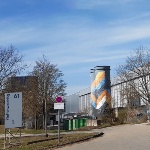- Abstract
-
All the data collected in BASIN 1 and SITE 1 on hydraulics and sediment, in particular at the hotspots must be evaluated to model the relationship between the flow field, erosion and sedimentation processes. Focusing on hotspots mobilized by erosive hydraulic conditions and their impact on the river ecosystem the critical flow parameters for the onset of erosion must be specified as well as the rate of contaminated sediment release (Witt, Westrich 2003). The sediment erosion mass flux plays an important role because it controls the source strength of pollutants and therefore, determines the concentration field not only of the resuspended particulate contaminants but also of the dissolved pollutants associated with the pore water. The erosion is the triggering mechanism followed up by the hydrodynamic transport, desorption and remobilization of sediment bound contaminants and, finally results in sedimentation of remaining polluted fractions downstream in headwaters and stagnant water bodies like groyne fields or harbors and flood plains . The combined effect of physical (grain size), chemical and biological (EPS) factors on the sediment erosion stability is not at all fully understood as to formulate the respective model terms (Haag, Westrich 2001). Therefore, a geostatistical evaluation of erosion relevant sediment parameters in terms of averaged values, spatial variance and uncertainty is required which allows to account for the probabilistic component of erosion and sedimentation processes and the resulting exposure (Li, Westrich 2001; Li 2004). Special interest will be given to the contaminated sediment depth profile which in combination with the duration of an erosive event and the rate of erosion controls the contaminant source strength. In addition, the hydraulic conditions at the hotspots will be derived from hydrological data for a rough erosion potential estimation. By multiple regression analysis of the hydraulic and sediment data a preliminary general parameterized description of erosion processesapplicable to the three river basins (Elbe, Scheldt, Llobregat) can be delivered. This enables to describe different hydrological scenarios with variable flow field and site specific erosion related sediment parameters (Witt 2004).
The modeling of sedimentation processes requires detailed information on suspended sediment parameters, in particular on the settling velocity of the contaminated fraction because of its model key function. Those parameters can only roughly be estimated from the existing data and hence, actual measurements in SITE 1 and particle size measurements must be performed (UfZ, Leipzig) . Further gaps in the data set, e.g. partitioning coefficient Kd, will be identified and filled by the experiments in SITE 1. The model approach will be validated by targeted experiments performed in SITE 1. The evaluation of the Elbe flood data towards a pollutant mass balance is expected to facilitate the formulation of a parameterized relationship for erosion processes.
Besides the physical aspects, the sedimentation and erosion behaviour of sediments is also determined by benthic organisms. Benthic organisms such as macrofauna, microphytobenthos and higher plants are organisms that live in or are attached to the bed. The presence of benthic organisms affect the (de)stabilisation of sediment in many different ways. These organisms are very much dependent on the physical and chemical properties of sediments. However, the presence and activity of benthic organisms can also reversely influence the physical and chemical properties and processes that take place within the sediment (Reise, 2002). Benthic organisms can change the sediment stability and thus have effect on erosion/deposition processes by their potential effect on both the bed shear stress and the shear strength of the sediment. The bed shear stress is a combined effect of hydrodynamic conditions near the sediment and the bottom roughness. Higher plants such as seagrass decrease the current velocities thereby reducig the local erosion. Other organisms increase the bottom roughness by creating elevations and depressions at the sediment surface. This greater bottom roughness will increase the shear stress and thus has a negative effect on bottom stability. The shear strength of the sediment bed is increased by the excretion of polymeric substances by organisms such as epipellic diatoms, sticking the sediment particles together and stabilising the sediment. Not only physical, but also chemical composition and processes in the sediment are influences by benthic organisms. This is both a direct result of their metabolic processes (production and respiration) and their behaviour (tube building, sediment reworking). Suspension feeders remove particles from the overlying water an deposit them to the sediment. Deposit feeders ingest sediment and return it to a different location in the sediment. This mixing of sediment by the activity of macrofauna is termed bioturbation. Unterprojekt von: Models for Assessing and Forecasting the Impact of Environmental Key Pollutants on Marine and Freshwater Ecosystems and Biodiversity - MODELKEY - Project manager
-
Bernhard Westrich
-
- Research assistants
-
Sandra Prohaska
Thomas Jancke - Department
- Duration
-
From: 2005.01.01
To: 2009.03.30
- Finances
-
Europäische Union
-


